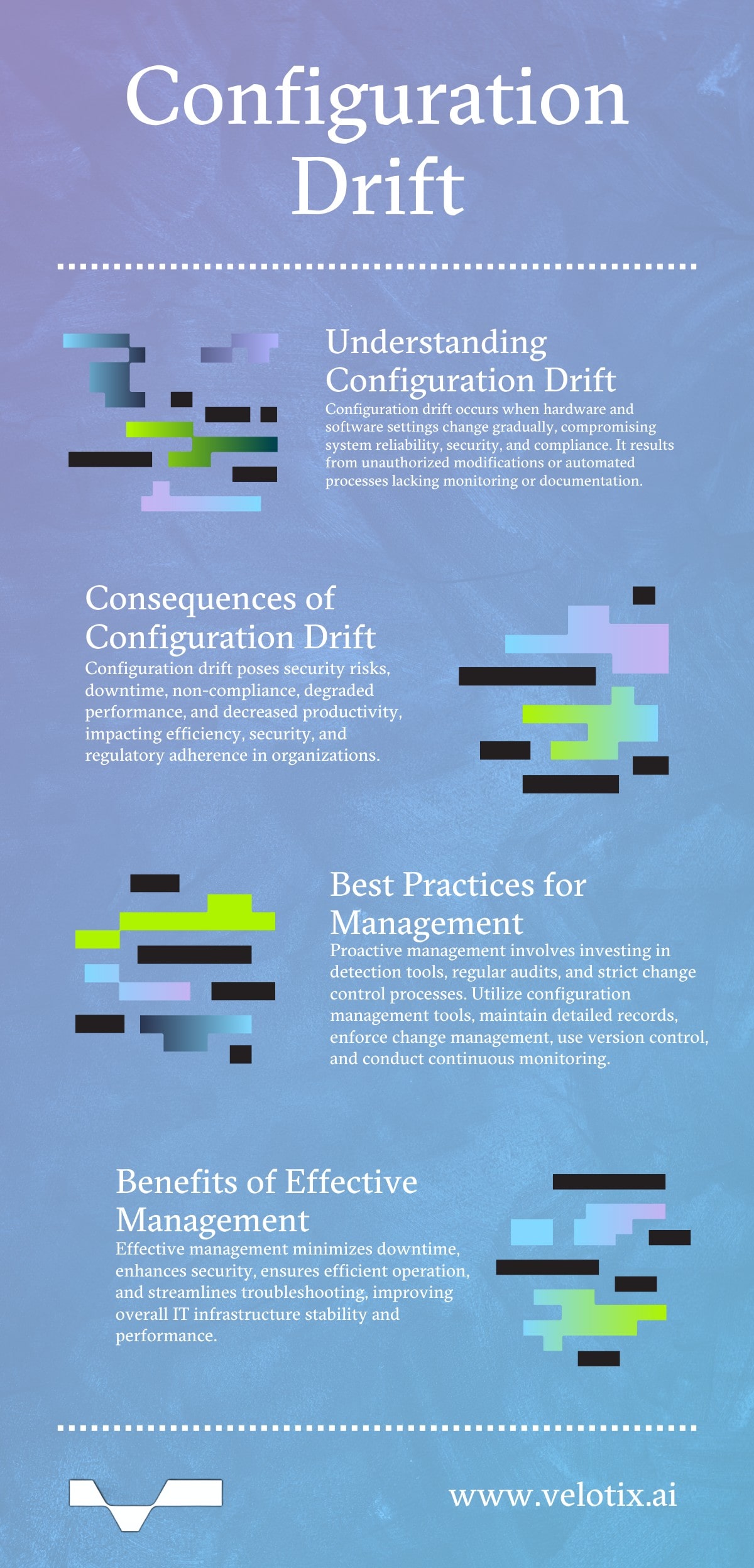What is Configuration Drift?
Configuration drift happens when the operational settings of an organization’s hardware and software environments change incrementally over time, leading to inconsistencies that can undermine system reliability, security, and compliance. It typically occurs because of modifications, manual interventions, or automated processes done on the fly without being thoroughly monitored or documented.
Examples of how configuration drift can impact different industries include:
- In the financial sector, configuration drift can result when unauthorized changes are made to transaction processing systems, leading to incorrect transaction handling or security vulnerabilities. For instance, unauthorized updates to a payment gateway might introduce errors in transaction processing, affecting the accuracy of financial reporting and potentially leading to regulatory compliance issues.
- In healthcare sectors, configuration drift could lead to discrepancies in patient data management systems, affecting patient care. For example, an unintended modification in the configuration of electronic health record (EHR) systems might result in incorrect patient information being displayed or accessed, compromising patient privacy and care quality.
- For telecommunications companies, configuration drift could impact network device settings, leading to network outages or degraded service quality. For instance, an overlooked router or switch configuration change could disrupt network traffic, affecting voice and data services for thousands of customers.
As IT environments become increasingly complex and dynamic, configuration drift monitoring and management have become critical challenges for maintaining operational stability and security.
Consequences of Configuration Drift
Configuration drift affects IT operations and business functionality. It can lead to multiple challenges that severely impact an organization’s efficiency, security, and regulatory compliance.
Security Issues
Configuration drift can inadvertently reveal security vulnerabilities by altering firewall settings, disabling necessary security controls, or introducing patch-level inconsistencies. These weak points provide openings for cyberattacks, which can lead to potential data breaches and unauthorized access to sensitive information.
Downtime
Unplanned system configuration changes can lead to system instability and crashes, resulting in unexpected downtime. This can affect service availability and lead to significant financial losses, especially for organizations that rely heavily on online transactions or services.
Non-compliance
For industries governed by strict regulatory standards mandating specific configurations for data protection and privacy, configuration drift can lead to non-compliance, resulting in hefty fines, legal consequences, and reputational damage.
Degraded Performance
Inconsistent configurations can lead to suboptimal system performance. Over time, these inefficiencies intensify, affecting the speed and reliability of IT services, frustrating users, and hampering critical operations.
Decreased Productivity
The time and resources spent identifying, troubleshooting, and correcting issues caused by configuration drift are often substantial. It can directly impact productivity, with IT teams forced to waste valuable time that could be spent on strategic initiatives.

Best Practices for Configuration Drift Management
Addressing configuration drift requires a proactive approach, including investment in configuration drift detection tools, regular audits, and strict change control processes that ensure all changes are tracked, documented, and aligned with organizational policies and compliance requirements.
- Use configuration management tools to automate the tracking and management of all system configurations. These tools help your business maintain an inventory of the current state of system configurations and enable quick restoration to a known good state in case of drift.
- Meticulous and detailed recordkeeping of network addresses for all hardware devices and the software versions installed on them, including any updates or upgrades is crucial for troubleshooting issues, understanding the impact of changes, and restoring systems to their intended configurations.
- Enforce strict change management processes that require all changes to be documented, reviewed, and approved before they’re implemented. This helps minimize unauthorized changes and ensures all modifications are accounted for and aligned with business objectives.
- Use version control for configuration files to track changes over time. This allows for easy comparison between different versions, which helps identify unintended changes and facilitates quick rollbacks to previous configurations when necessary.
- Conduct audits and monitoring of systems and networks to catch configuration drift early. Monitoring should be continuous, with alerts set up for unauthorized changes, ensuring any drift is quickly identified and addressed.
While configuration drift monitoring can be time-consuming, it can significantly enhance your company’s IT infrastructure stability and security.
- By minimizing unauthorized changes, systems are less likely to experience unexpected downtime or performance issues, ensuring reliable service delivery.
- Proactively managing configuration drift helps improve your organization’s security posture, identifying and fixing vulnerabilities quickly to reduce the risk of data breaches or cyberattacks.
- Maintaining consistent configurations ensures systems operate more efficiently, leading to higher performance and user satisfaction.
- Streamlining configuration management reduces the time and financial resources spent on troubleshooting and resolving configuration drift issues.Adhering to these best practices ensures effective configuration drift management that maintains the integrity, security, and performance of your organization’s IT environment. With advanced features like purpose-based access control, centralized data management, and swift policy compliance, AI-powered Velotix helps businesses prevent configuration drift and optimize their IT operations for peak performance.
